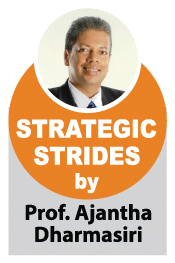 Five years have passed by. I used to live in Negombo and know many who lost their lives in the Easter tragedy that engulfed serene Sri Lanka. There was surely no repetition of “black July” or “dark Digana.”
Five years have passed by. I used to live in Negombo and know many who lost their lives in the Easter tragedy that engulfed serene Sri Lanka. There was surely no repetition of “black July” or “dark Digana.”
It is amazing to see the restrained response of affected masses with grief and sorrow on one hand yet compassion and care on the other hand. Yet, the mysteries surrounding the “brains” behind it still remain unresolved. Today’s column is a reflection on authentic leadership in the context of the Easter tragedy.
Overview
Many have commented on the lapses of execution related to intelligence alerts. Also, there are still finger pointing with the typical blame game of actions, inactions, and reactions. As a learner and practitioner of management, I simply see it as a leadership crisis. A heavy price had to be paid for the massive lethargy of the so-called important yet incompetent individuals. One ray of hope emerged is the authentic leadership aptly demonstrated by religious leaders in showing unity and solidarity.
My intention is not to instill personal glory to an individual, but to highlight the fulfilment of a timely need in avoiding an inter-religious or inter-racial conflict. It was authentic leadership much in evidence, in the context of key political leaders showing the absence of it.
Authentic leaders in dire deed
Leadership literature is full of fancy jargon and multitude of packaging as well as re-packaging. One significant trend in the recent past in the East and West alike is the focus on authentic leaders. In essence, leadership is all about inspiring, influencing and initiating. It is more than positions and titles as it involves decisions and actions. Authentic leaders had always been there in the world. All great religious leaders are obviously authentic. From Thripitaka, Bible, Koran, and Hindu texts, many such examples could be found.
How would an authentic leader differ from the rest? Forbes magazine gives the following four reasons:
1. Authentic leaders are self-aware and genuine. Authentic leaders are aware of their strengths, their limitations, and their emotions. They also show their real selves to their teams. They do not act one way in private and another in public; they don’t hide their mistakes or weaknesses out of fear of looking weak. They also realise that knowing themselves better is an endless journey, never complete.
2. Authentic leaders are mission driven and focused on results. They are able to put the mission and the goals of the organisation ahead of their own self-interest. They do the job in pursuit of results, not for their own power, money, or ego.
3. Authentic leaders lead with their heart, not just their minds. They are not afraid to show their emotions, their vulnerability and to connect with their employees. This does not mean authentic leaders are “soft.” In fact, communicating in a direct manner is critical to successful outcomes, but it’s done with empathy; directness without empathy is cruel.
4. Authentic leaders focus on the long-term. From a business point of view, corporate leaders are focused on long-term shareholder value, not in just beating quarterly estimates. From a socio-cultural point of view, it highlights the need to go beyond petty politics of wooing the voters to commit towards long term wellbeing of all.
We saw all the above four aspects in action with the rare unity among Catholic, Islamic, Buddhist and Hindu religious leadership as an inter-religious front, in avoiding bloodshed in the aftermath of the awful carnage.
Leaders serve and laggards survive
When you consider the five hundred and fifty Jathaka stories, more than fifty percent of the time, the Bodhisathva is portrayed as a leader. In some cases, as a one who serve others. In brief, a servant leader is a servant first. The simple motto is service first. Jesus Christ washed the feet of his disciples and requested them to do so for the others. It is a true demonstration of servant leadership. There are instances from Prophet Mohamed’s life too where the servant leadership characteristics could be found.
“Without trust we don’t truly collaborate; we merely coordinate or, at best, cooperate; It is trust that transforms a group of people into a team,” said Stephen Covey, the author of Seven Habits of Highly Effective People. We saw that happening in the religious circles guiding the followers.
Robert Greenleaf describes the servant dimension of an authentic leader as follows:
“The servant-leader is a servant first. Becoming a servant-leader begins with the natural feeling that one wants to serve, to serve first. Then conscious choice brings one to aspire to lead. That person is sharply different from one who is a leader first. The difference manifests itself in the care taken by the servant first to make sure that other people’s highest priority needs are being served. The best test, and the most difficult to administer, is this: Do those served grow as persons? Do they, while being served, become healthier, wiser, freer, more autonomous, more likely themselves to become servants?”
We, in fact, saw this in abundance in hundreds of Catholic priests who were with affected families in Katuwapitiya and Kochchikade. Instead of shouting slogans and holding placards, they carried the coffins of the departed ones while consoling the surviving relatives. It was a rare case of breeding authentic leadership in transforming followers to empowered leaders.
A leader needs a team to move towards a shared dream. It is not being autocratic but democratic, not being coercive but collaborative. The world of sports has many such examples where a leader harnesses a winning team. Authentic leaders have to awaken the team spirit in fostering synergy. Leveraging on the strengths of each team member, the leader can collectively do more.
What Mahathma Gandhi demonstrated in rallying a nation with non-violence against a forceful empire is this reality. He was a true synergist and the community, even while he was in jail practiced what he preached. What we are witnessing in the aftermath of the Easter tragedy also shows the rays of hope with authentic leadership in action.
Serving leaders and subservient laggards
When authentic leadership was demonstrated in religious fronts, the opposite was seen in the political fronts. Instead of servant leaders, subservient laggards accusing one another, engaging in the typical blame game can still be seen. Thanks to the media, leaders and laggards in the Sri Lankan context were amply exposed with their words and deeds.
Social media, allowed again, are full of bouquets towards emergence of authentic leadership from religious fronts while throwing brickbats at the opportunistic politicians. The sarcasm is seen at its highest with regards to the accusations of inactivity and incompetence. As there is no smoke without fire, it invites for a sincere sole searching by all political leaders at least to learn what authentic leadership is all about.
St. Mother Theresa of Calcutta demonstrated her authentic leadership through what she did with destitute street children. We have reached a time where there is a dire need to heal the wounded hearts and minds through close association, caring communication and core counselling where needed. Religious and laity alike can show their authenticity in rising to the occasion as committed leaders.
The way religious leadership was demonstrated during the aftermath of the Easter tragedy is not only a demonstration of leading from the front but also breeding empowered leaders who would silently do the needful.
Sowing love where hatred was rampant, and guiding the flock towards peaceful behavior were much evident in the past few days. In fact, Church leaders lived the Gospel values not only in being “sheep among the wolves,” but also being “wise as a serpent and innocent as a dove.”
The Catholic Church worldwide, despite issues, scandals, and controversies, has sustained itself for more than 2000 years. With its clear mission with heaven in mind, it will move along, with a sustained spirit of loving one another. We in Sri Lanka with a 7% Catholic population can look forward to a meaningful engagement with all other religions in collectively contributing to nation re-building. Authentic leadership demonstrated by religious leaders has become a ray of hope for such an enormous endeavour in uniting a divided country.
Way forward
Living with authentic leaders on one front and awful laggards on another front is not comfortable. Yet, it is the reality. Transforming laggards to leaders is not so easy. Yet, it is necessary. Justice is still sought for the victims even after the long lapse of five years. Controversies, confusions, and convolutions have surrounded the Easter tragedy in making it the “mystery of mysteries.” “Three things cannot be long hidden: the sun, the moon, and the truth” said the Buddha. May the real truth be revealed and justice done.









